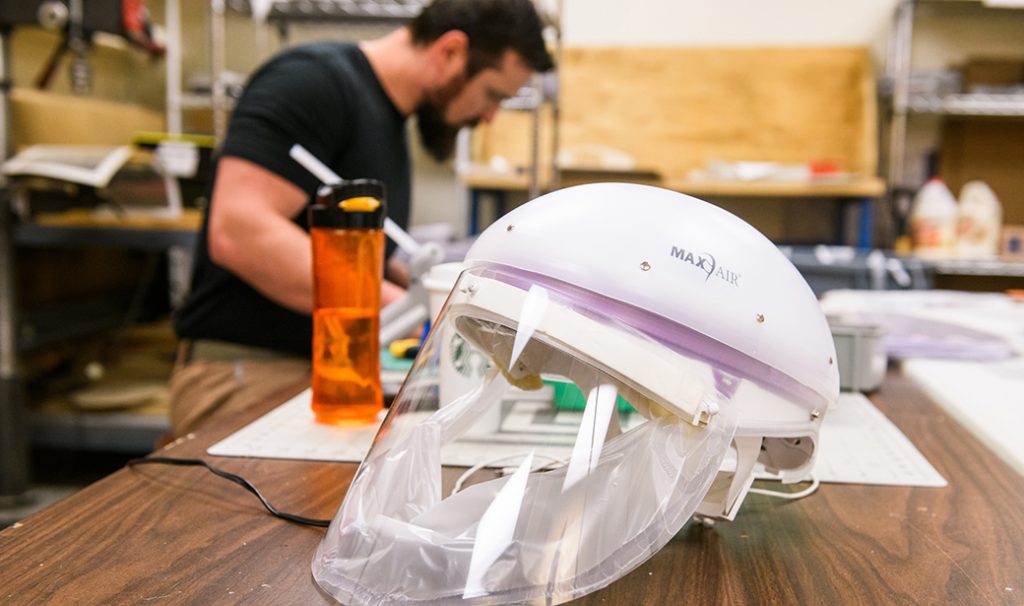May 04, 2020

Damon Coyle assembles replacement CAPR masks he helped design as part of the Hacking COVID-19 Task Force. The masks can be worn by MU Health Care doctors, nurses and respiratory specialists to protect them against airborne viruses.
Kevin Gillis heard stories about hospitals that were overwhelmed by the COVID-19 outbreak and unable to get enough equipment to protect their front-line health care workers. He wanted to do something to prevent that from happening in mid-Missouri. And as the interim chair of the University of Missouri’s Department of Biomedical, Biological and Chemical Engineering, he had a deep bench of innovative problem-solvers ready to help. The only question was how.
“What I saw was a Wild West out there of people making 3D-printed masks and all that,” Gillis said. “I was hoping to harness that energy toward helpful pursuits that the health care community would be willing and able to use.” Gillis and his cross-campus volunteer group, called the Hacking COVID-19 Task Force, met with MU Health Care leaders to see how they could help. They decided the top priority was to create a version of the controlled air-purifying respirator (CAPR) masks worn by doctors, nurses and respiratory therapists to guard against infection from airborne viruses.
“We met on a Friday, and by Saturday morning, this group had built their first prototype for a CAPR mask,” said Stephen Barnes, MD, the planning chief for MU Health Care’s COVID-19 response team. “Less than a 24-hour turnaround. It was amazing.”
A CAPR unit includes a helmet with an attaching visor and cuff combination that forms a seal covering the whole face. There is a fan in the helmet that filters air and pushes it down the wearer’s face, creating a positive-pressure environment inside the mask that keeps viruses out. It is worn when there could be a mist of infected fluid in the air.
The helmets are permanent, and the visors can be worn a handful of times — with disinfection between usages — until the cuff stretches out too much to provide a tight seal along the jaw line. Barnes said MU Health Care has an adequate supply of the disposable visors but could need more if there is a surge of patients with COVID-19. New visors are not currently available. So the Hacking COVID-19 fabrication team got busy building new ones. The four-person fabrication team includes College of Engineering director of facilities Ron Monson; engineering technicians Matthew Marciniak and Ghassan Al Bahhash; and Damon Coyle, whose unofficial job title is the MacGyver of the MU School of Medicine’s Shelden Clinical Simulation Center.

Hunter Hofmann, MD, breathes deeply as Stephen Barnes, MD, releases a puff of smoke during testing of a prototype CAPR mask by MU’s Hacking COVID-19 Task Force.
The challenges of the project included reverse-engineering the manufacturer’s mask so it could be accurately reproduced and finding a cuff material that mimicked the original.
“It’s a stretchy polymer of some kind, so think of it as a more robust, more elastic cling wrap,” Coyle said.
On April 14, the fabrication team tested five mask prototypes in a meeting with MU Health Care doctors and nurses. Hunter Hofmann, MD, the chief of the Division of Pulmonary, Critical Care and Environmental Medicine, tried on the different options while Barnes checked to see if puffs of smoke got inside the mask when Hofmann inhaled deeply. Some smoke invaded the mask around Hofmann’s temples, so the fabrication team made a few tweaks. By April 17 — just one week after the initial meeting with MU Health Care leaders — the new mask passed the smoke test.
The visor part of the mask is made with the kind of clear plastic used in soda pop bottles. After experimenting with a cuff made of spandex, Coyle said the team settled on a material comparable to an industrial-strength trash bag. “It’s totally impermeable to liquids and gasses if sealed correctly,” Coyle said. “Another tweak was to move the cuff material farther up on the visor to eliminate the outlet hole near the temple. The final test showed no appreciable difference between the manufacturer’s mask and ours.”
The fabrication team, with help from engineering technician Mike Harlow, spent a week making and assembling 1,000 masks in the College of Engineering’s machine shop. The masks will serve as MU Health Care’s emergency supply if the current stock of manufacturer’s masks run out.
“The nurses, docs and the respiratory therapists are using the masks every day and using them with conservation in mind,” Barnes said. “Before we had the locally made masks, they might have pushed their mask to the limit because they didn’t know if we had adequate resupply. Now, having a cushion will make our staff more comfortable in terminating the use of a mask as it wears over time.”
Meanwhile, other Hacking COVID-19 Task Force teams are working on separate projects, such as protective barrier for anesthesiologists to use when performing intubation procedures, a device that can help reposition patients with COVID-19 in their beds and a unit that will sterilize N95 masks with hydrogen peroxide vapor.
“This mask project is a tremendous success story, not really due to me — I just put people together,” Gillis said. “They had the skill sets, they had the material and they had the motivation and can-do attitude. That’s what made it possible.”